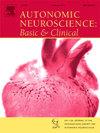体位性心动过速综合征(POTS)主动站立与直立倾斜试验的生理与临床比较
IF 3.3
4区 医学
Q2 NEUROSCIENCES
引用次数: 0
摘要
直立倾斜试验(HUT)和主动站立试验(AST)用于诊断体位性心动过速综合征(POTS),但其相对诊断准确性尚不清楚。这需要在标准化条件下进行直接比较。我们的目的是比较AST和HUT在POTS中的血流动力学反应和诊断准确性。为了解决这个问题,60名POTS患者在同一天完成了10分钟AST和HUT。在10分钟仰卧基线和每次测试期间记录搏动血流动力学。计算每次测试的δ值(直立1分钟平均值减去基线平均值)。Δ[心率]随着时间的推移显著增加(1_Min: 28 bpm到10_Min: 40 bpm;PTime & lt;0.001), HUT更大(33 bpm vs 37 bpm;PASTvHUT = 0.01),具有显著的时间与条件相互作用(38 bpm vs. 42 bpm;品脱& lt;0.001)。Δ[中风量]随着时间的推移而下降(1_Min: -18 ml至10_Min: -32 ml);PTime & lt;0.001),没有显著的试验或相互作用效应(PASTvHUT = 0.36;品脱= 0.21)。Δ[SBP]降低(1_Min:−0.3 mmHg至10_Min:−5.7 mmHg);PTime & lt;0.001),没有测试或相互作用的影响。在AST期间符合POTS心率标准的患者较少(AST: 74% vs. HUT: 98%;p & lt;0.001)。将AST的阈值降至27bpm缩小了差距,但HUT的阈值仍然明显更高(AST: 83% vs HUT: 98%;p = 0.02)。房颤患者体位性心动过速在AST和HUT之间的差异。符合心率诊断标准的POTS患者比例在AST和HUT之间存在显著差异,这种差异可以通过降低AST的心率阈值来缓解。本文章由计算机程序翻译,如有差异,请以英文原文为准。
Physiological and clinical comparison of active stand and head-up tilt tests in Postural Orthostatic Tachycardia Syndrome (POTS)
Head-up tilt (HUT) and active stand tests (AST) are used in the diagnosis of Postural Orthostatic Tachycardia Syndrome (POTS), but their relative diagnostic accuracy is unclear. This necessitates a direct comparison under standardized conditions. We aimed to compare the hemodynamic responses and diagnostic accuracy of AST vs. HUT in POTS.
To address this, patients with POTS (n = 60) completed a 10-min AST followed by HUT on the same day. Beat-to-beat hemodynamics were recorded during 10-min supine baselines and each test. Delta values were calculated for each test (upright 1-min averages minus baseline average).
Δ[heart rate] increased significantly over time (1_Min: 28 bpm to 10_Min: 40 bpm; PTime < 0.001), and was greater for HUT (33 bpm vs. 37 bpm; PASTvHUT = 0.01), with significant Time x Condition interaction (38 bpm vs. 42 bpm at10min; PINT < 0.001). Δ[stroke volume] declined over time (1_Min: -18 ml to 10_Min: -32 ml); PTime < 0.001), with no significant test or interaction effects (PASTvHUT = 0.36; PINT = 0.21). Δ[SBP] decreased (1_Min: −0.3 mmHg to 10_Min: −5.7 mmHg); PTime < 0.001) over time, with no test or interaction effects.
Fewer patients met POTS heart rate criteria during the AST (AST: 74 % vs. HUT: 98 %; p < 0.001). Lowering the threshold to 27 bpm for AST narrowed the gap but was still significantly higher for HUT (AST: 83 % vs HUT: 98 %; p = 0.02).
Orthostatic tachycardia differs between AST and HUT in patients with POTS. The proportion of patients with POTS meeting the heart rate diagnostic criteria differs significantly between AST and HUT, a discrepancy that can be mitigated by lowering the heart rate threshold for the AST.
求助全文
通过发布文献求助,成功后即可免费获取论文全文。
去求助
来源期刊
CiteScore
5.80
自引率
7.40%
发文量
83
审稿时长
66 days
期刊介绍:
This is an international journal with broad coverage of all aspects of the autonomic nervous system in man and animals. The main areas of interest include the innervation of blood vessels and viscera, autonomic ganglia, efferent and afferent autonomic pathways, and autonomic nuclei and pathways in the central nervous system.
The Editors will consider papers that deal with any aspect of the autonomic nervous system, including structure, physiology, pharmacology, biochemistry, development, evolution, ageing, behavioural aspects, integrative role and influence on emotional and physical states of the body. Interdisciplinary studies will be encouraged. Studies dealing with human pathology will be also welcome.

 求助内容:
求助内容: 应助结果提醒方式:
应助结果提醒方式:


